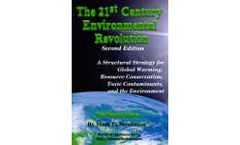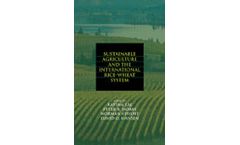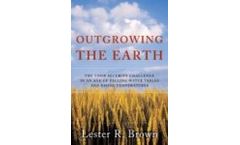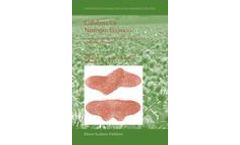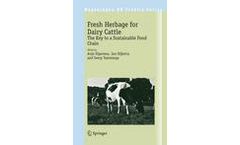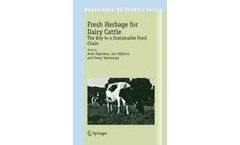Food Supply Books
-
First Wave Agricultural Revolution
Alvin Toffler's First Wave began approximately 10,000 years ago. That time marked the end of the Old Stone Age (the Paleolithic) and the beginning of the New Stone Age or the Neolithic. This is approximately when the Agricultural Revolution started. People began clearing land and tilling the soil in order to plant crops as opposed to gathering what nature provided or failed to provide. They also ...
-
Agricultural and Environmental Sustainability: Considerations for the Future
Understand sustainable development from economic, ecological, and social perspectives As world population continues to increase, the need grows for a safe, sustainable supply of food. Agricultural and Environmental Sustainability: Considerations for the Future provides the latest research results and vital information on the process of producing an enduring food supply that is healthy for ...
-
Dryland Agriculture, Second Edition
Dryland agriculture is of more consequence now than ever because the world’s dependence on food produced in dryland areas is even greater. In recognition of this, and the fact that global food supply is increasingly interconnected, this volume takes a world view of dryland production continent by continent. The initial chapters of the monograph address the principles that underlie all dryland ...
-
Sustainable Agriculture and the International Rice-Wheat System
Addressing a topic of major importance to the maintenance of world food supplies, this reference identifies knowledge gaps, defines priorities, and formulates recommendations for the improvement of the rice-wheat farming system. The book reveals new systems of rice intensification and management and illustrates the application of no-till and conservation farming to the rice-wheat system. With ...
-
Improving the Productivity and Sustainability of Rice-Wheat Systems: Issues and Impacts
IRRI, CIMMYT, and ASA-CSSA-SSSA brought together world experts to explore the future of the global food supply in the context of one of the most widely used production systems. Rice-wheat rotation in the Indo-Gangetic Plains and Asia is a system where Green Revolution gains are probably not repeatable and must give way to new solutions to issues of malnutrition, sustainability, and economic ...
-
Environmental Health in Emergencies and Disasters
This volume distills what is known about environmental health during an emergency or disaster. It draws on results from the International Decade for Natural Disaster Reduction, and on experience with sustainable development between the two Earth Summits, in Rio de Janeiro and Johannesburg. It is intended for practitioners, as well as for policy-makers and researchers, and thus covers both general ...
-
Crops and Man, Second Edition
Jack R. Harlan conceived the prevailing concepts of how the activities of human societies have shaped the evolution of crops used for food, feed, and fiber. Harlan collected and introduced over 12,000 accessions of plants into the United States. The world food supply now depends largely on only 12 to 15 plant species. Erosion of diverse gene sources from ancient landraces continues and more ...
-
Human Health and the Environment
The twentieth century has seen a remarkable evolution in environmental health and environmental protection concerns and concepts in the United States. Human Health and the Environment: A Turn of the Century Perspective is intended to be a commentary, suitable for a wide audience, on the broad aspects of the relationship between human health and the environment at the turn of the century. ...
-
Drought Management on Farmland
At last, integrated management of drought on farms is dealt with in one comprehensive book. Although drought is a highly variable, near-universal natural phenomenon which has repercussions on a country's water and food supplies and many other sectors of the economy, there are many ways of avoiding, resisting and mitigating the effects of drought. Pro-active preparedness entails using the ...
-
Outgrowing the Earth: The Food Security Challenge in an Age of Falling Water Tables and Rising Temperatures
In recent months, rising oil prices have focused the world’s attention on the depletion of oil reserves. But the depletion of underground water resources from overpumping is a far more serious issue. Excessive pumping for irrigation to satisfy food needs today almost guarantees a decline in food production tomorrow. There are substitutes for oil, but there are no substitutes for water. ...
-
Catalysts for Nitrogen Fixation
Biological nitrogen fixation provides more than 50% of the total annual input of the essential element nitrogen to world agriculture. Thus, it is of immense agronomic importance and critical to food supplies, particularly in developing countries. This book, with chapters authored by internationally renowned experts, provides a comprehensive and detailed account of the fascinating history of the ...
-
Breaking New Ground: A Personal History
Lester Brown traces his life from a small farm in rural southern New Jersey through his personal evolution into the world's foremost authority on global environmental issues. The first in his family to graduate from elementary school, he reveals what inspired him—and the millions of those who have read his books—to become environmentally ...
-
Climate Change: An Integrated Perspective
Global climate change - rapid, substantial and human induced - may have radical consequences for life on earth. The problem is a complex one, however, demanding a multi-disciplinary approach. A simple cost-benefit analysis cannot capture the essentials, nor can the issue be reduced to an emissions reduction game, as the Kyoto process tries to do. It is much more sensible to adopt an ...
-
Fresh Herbage for Dairy Cattle
Product quality and a sustainable food chain of ruminant products are largely determined by animal nutrition, in which forage is the major feed source. Forages and grasslands play a unique role in agriculture because they contribute through animals to our food supply and to the abatement of environmental problems. Interest in grassland management and grass utilization for dairy production in ...
-
Fresh Herbage for Dairy Cattle
Product quality and a sustainable food chain of ruminant products are largely determined by animal nutrition, in which forage is the major feed source. Forages and grasslands play a unique role in agriculture because they contribute through animals to our food supply and to the abatement of environmental problems. Interest in grassland management and grass utilization for dairy production in ...
-
Threats to Food and Water Chain Infrastructure
The malicious contamination of food and water supplies for terrorist purposes is a real and current threat: deliberate contamination at one location could have severe global public health, trade and consumer confidence implications. The NATO Advanced Research Workshop responded to increasing concern in many countries that chemical, biological or radionuclear agents might be used intentionally to ...
-
Full Planet, Empty Plates: The New Geopolitics of Food Scarcity
With food scarcity driven by falling water tables, eroding soils, and rising temperatures, control of arable land and water resources is moving to center stage in the global struggle for food security. “In this era of tightening world food supplies, the ability to grow food is fast becoming a new form of geopolitical leverage. Food is the new oil,” Lester R. Brown ...
-
Threats to Food and Water Chain Infrastructure
The malicious contamination of food and water supplies for terrorist purposes is a real and current threat: deliberate contamination at one location could have severe global public health, trade and consumer confidence implications. The NATO Advanced Research Workshop responded to increasing concern in many countries that chemical, biological or radionuclear agents might be used intentionally to ...
-
Effects of Climate Change and Variability on Agricultural Production Systems
Evidence shows that global climate change is occurring. Research and debate continue on the role of increasing atmospheric concentrations of greenhouse gases in influencing climate change. Many sectors are or will be influenced by changing climate and climate variability, including increasing global temperatures, changing precipitation patterns, and increased frequency of unusual weather events. ...
-
Micropropagation of Woody Trees and Fruits
The key technology for biomass production of woody species is propagation via micropropagation. Recent development of in vitro culture techniques has made it possible to commercially propagate useful trees, both forest and fruit trees. In this book comprehensive information is provided on micropropagation of economically important forest and fruit trees, which is usually available in scattered ...
Need help finding the right suppliers? Try XPRT Sourcing. Let the XPRTs do the work for you
